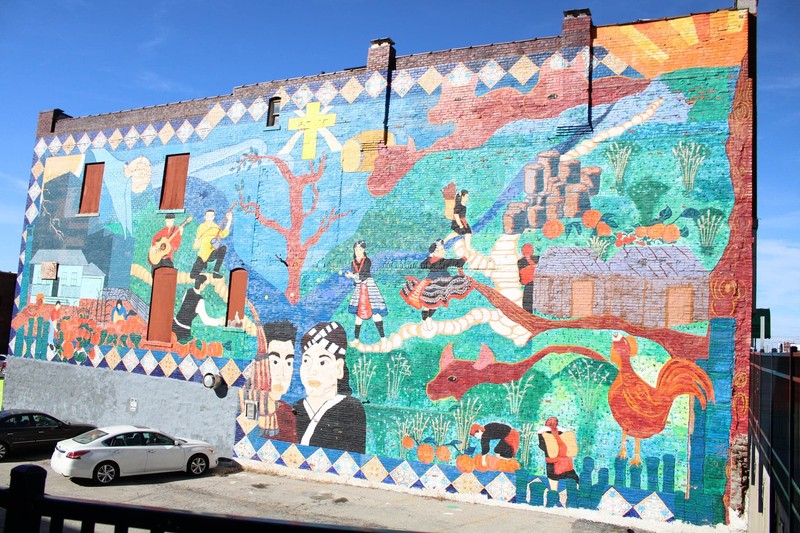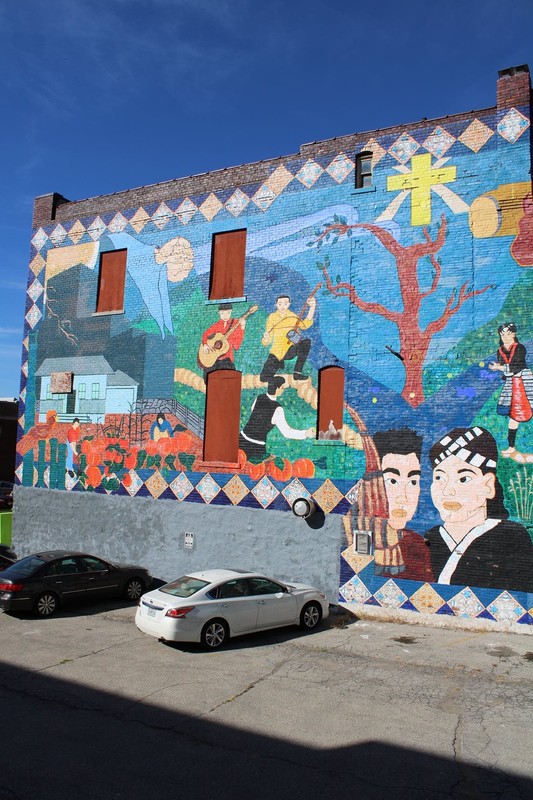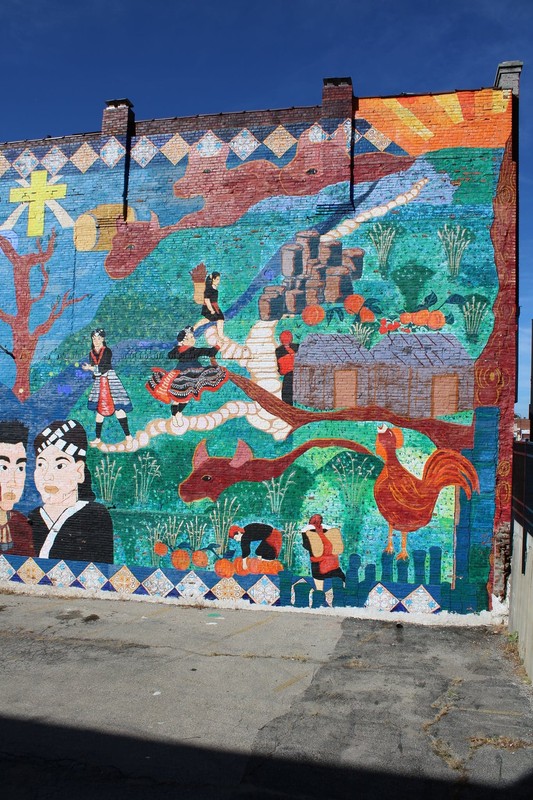Facing the Past, Looking to the Future: A Kansas Hmong Storycloth
Introduction
Text-to-speech Audio
Artists Jose Faus and Alisha Gambino helped area school children design and create this mural, which was completed in 2005 and honors the Hmong community of Kansas. The mural portrays Hmong culture both traditional and modern, using the style of a Hmong embroidered story cloth. The Hmong began arriving in significant numbers from Southwest Asia to American communities such as Kansas City in the 1970s. Today, there are around two thousand Hmong in Kansas City, Kansas. This mural shares some of the unique history and culture of this community, with a focus on how they work, play, form families, and celebrate.
Images



Backstory and Context
Text-to-speech Audio
This mural was completed in 2005 by Jose Faus and Alisha Gambino in combination with a group of local children. Not only was it the kids' idea to paint the mural in the style of a traditional Hmong story cloth, but according to Faus, they also did "95 percent of the work" on the mural. Rather than just do the painting himself, Faus chose to work with the kids directly and support them through the process of planning, design, and painting. When asked to describe the final work, Faus said it was "a simple design, very childish, but it's just great in terms of the themes that it captures."
"Facing the Past, Looking to the Future" is a representation of the Hmong people in Kansas City, Kansas, and their relationships with each other, their culture, and their traditions. The border is painted in the style of an embroidered pattern, and the entire mural's dominant colors are green and blue; both of these are common aspects of story cloths. The actions of the people in the mural carry both their surface-level meanings and more metaphorical ones. For example, the children tossing the ball across the river represent two things. The first thing represented is a Hmong cultural practice, a game of catch that can also act as a "courting ritual." In the game, a boy throws the ball to whichever girl he likes, and if she throws it back to him, that means she feels the same way. More metaphorically, it represents Hmong Americans' relationship to their culture - they "toss the ball" between "new" and "old" practices in a sort of balancing act.
The Hmong People
The Hmong are a unique Asian people who originated in Central China. Today around three million of them live in Southwest China, as well as neighboring countries like Vietnam and Laos, where communities of Hmong were established as early as the eighteenth century. However, thanks to war and unrest in the mid-to-late twentieth century, many others live in diaspora in countries such as the United States, Europe, and Thailand.
The origins of the Hmong people in America traces to the 1970s when the CIA recruited many Hmong men for aid during the Vietnam War. However, when the United States began to withdraw from Vietnam and Laos in 1974, the Hmong people were indiscriminately targeted by Vietnamese communists for helping the Americans and the French before them. With all of them in grave danger of being hunted down and killed, the people began fleeing en masse to Thailand as refugees.
Local Laotian Hmong refugee and professor of anthropology, Wayne Yang, was only five years old when he fled Laos in 1979 with his family, but he remembers the experience vividly. Yang described his experience for the Bonner Springs newspaper The Chieftan in 2007:
Wayne said his parents woke him up one morning, with smoke in the air, and his parents told him and his siblings they had to hurry because the Vietnamese were coming. They quickly packed together a few belongings and set out through the jungle.
"My father, right before we left, he threw his gun away, threw it back at the house," Wayne said. "That way the communists couldn't say we were fighting against them."
Wayne remembers being in the jungle with no food with other Hmong families, making their way to the Thai border on a 16-day trek. ... [and] times when the jungle was bright with fire, as the communists tried to burn the Hmong refugees out. ... [Many] Hmong died of starvation in the jungle.Sarah Yang estimates only a third of her relatives were able to escape the country.
After reaching Thailand, many then permanently settled in the United States in cities all around the country. Today about two thousand Hmong people live in Kansas City, Kansas, and the surrounding area.
The Hmong Story Cloth
Storytelling has always been an important part of Hmong culture. The story cloth, a way for them to tell people about their past through colorful and complex embroidered panels, developed in the mid-1970s in refugee camps in Thailand. Not only did these story cloths serve as a way for the refugees, who had lost everything when they left Vietnam and Laos, to make a livelihood for themselves, but they also breached the language barrier, allowing the Hmong people to speak about their past to people all around the world, including Hmong children who had been born and raised elsewhere.
Sources
Downtown Kansas City, Kansas Avenue of Murals Brochure, Visit Kansas City, Kansas. Accessed September 30th, 2022. https://www.roxieontheroad.com/wp-content/uploads/2020/10/Mural-Brochure.pdf.
Boyer, Carolyne. Hmong people are a long way from home, The Chieftan. May 16th, 2007. Accessed September 30th, 2022. http://www.bonnersprings.com/news/2007/may/16/hmong_people_are/.
Hmong Story Cloth, Kansapedia - Kansas Historical Society. Accessed September 30th, 2022. https://www.kshs.org/kansapedia/hmong-story-cloth/10367.
Hmong Story Cloth Mural - From Interview With Jose Faus, KCUR 89.3 YouTube Channel. August 3rd, 2011. Accessed September 30th, 2022. https://www.youtube.com/watch?v=D_9fUUjKOvw.
Crossing The River: Hmong Story Cloths, Missoula Art Museum. June 24th, 2014. Accessed September 30th, 2022. https://missoulaartmuseum.org/exhibits/crossing-the-river-hmong-story-cloths.
Hmong Story Cloths: A Modest Introduction, City of Pella. Accessed September 30th, 2022. https://www.cityofpella.com/DocumentCenter/View/1816/Hmong-Story-Cloths?bidId=.
Photo Credit: Brandon Camacho
Photo Credit: Brandon Camacho
Photo Credit: Brandon Camacho
